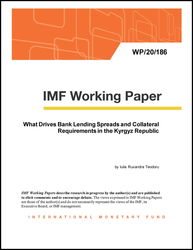
What Drives Bank Lending Spreads and Collateral Requirements in the Kyrgyz Republic
What Drives Bank Lending Spreads and Collateral Requirements in the Kyrgyz Republic
READ MORE...
Volume/Issue:
Volume 2020
Issue 186
Publication date: September 2020
ISBN: 9781513556543
$18.00
Add to Cart by clicking price of the language and format you'd like to purchase
Available Languages and Formats
| English |
Prices in red indicate formats that are not yet available but are forthcoming.
Topics covered in this book
This title contains information about the following subjects.
Click on a subject if you would like to see other titles with the same subjects.
Banks and Banking , Money and Monetary Policy , Public Finance , WP , financial leverage , return on assets , market power , loan s , pressure bank , concentration index , bank loan , bank-financed investment , bank size , group loan , interest rate spread , intermediation cost , average cost , Loans , Collateral , Credit , Bank credit , Legal support in revenue administration , Central Asia , Bank lending spreads , financial intermediation , bank competition , uncollateralized loan , investment activity
Summary
Limited access to finance and its high cost have contributed to relatively low levels of private investment and subpar growth in the Kyrgyz Republic. Interest rate spreads have moderated in recent years, but remain high from both a regional and global perspective. At the same time, collateral requirements applied by banks are onerous and also constrain the quantity of credit supplied. This paper identifies a range of factors that could lower spreads in the Kyrgyz Republic: more competition, higher capital, lower credit risk, larger loan size, lower deposit rates and external funding costs, as well as a stronger legal framework. Lower operating costs appear critical to reduce relatively higher spreads for small and medium-sized banks. At the same time, a stronger legal framework and greater transparency on borrowers’ creditworthiness would help reduce the high collateral requirements. Reforms in all these areas would support greater financial inclusion in the aftermath of the pandemic, and could thus be a key source of sustainable and inclusive growth in the Kyrgyz Republic.
Copyright © 2010 - 2024
Powered by:
AIDC



